1997 PONTIAC PONTIAC ESP
[x] Cancel search: ESPPage 21 of 419
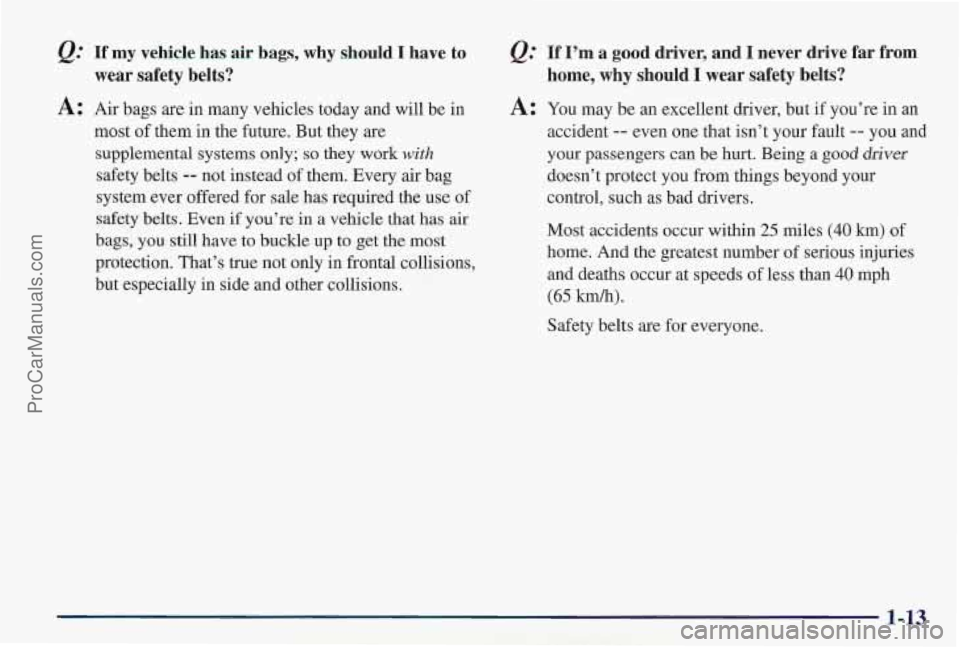
If my vehicle has air bags, why should I have to
wear safety belts?
A: Air bags are in many vehicles today and will be in
most of them in the future. But they are
supplemental systems only;
so they work with
safety belts -- not instead of them. Every air bag
system ever offered for sale has required the use
of
safety belts. Even if you’re in a vehicle that has air
bags, you still have to buckle up to get the most
protection. That’s true not only in frontal collisions,
but especially in side and other collisions.
If I’m a good driver, and I never drive far from
home, why should
I wear safety belts?
A: You may be an excellent driver, but if you’re in an
accident
-- even one that isn’t your fault -- you and
your passengers can
be hurt. Being a good driver
doesn’t protect you from things beyond your
control, such as bad drivers.
Most accidents occur within
25 miles (40 km) of
home. And the greatest number of serious injuries
and deaths occur at speeds of less than
40 mph
(65 km/h).
Safety belts are for everyone.
1-13
ProCarManuals.com
Page 78 of 419
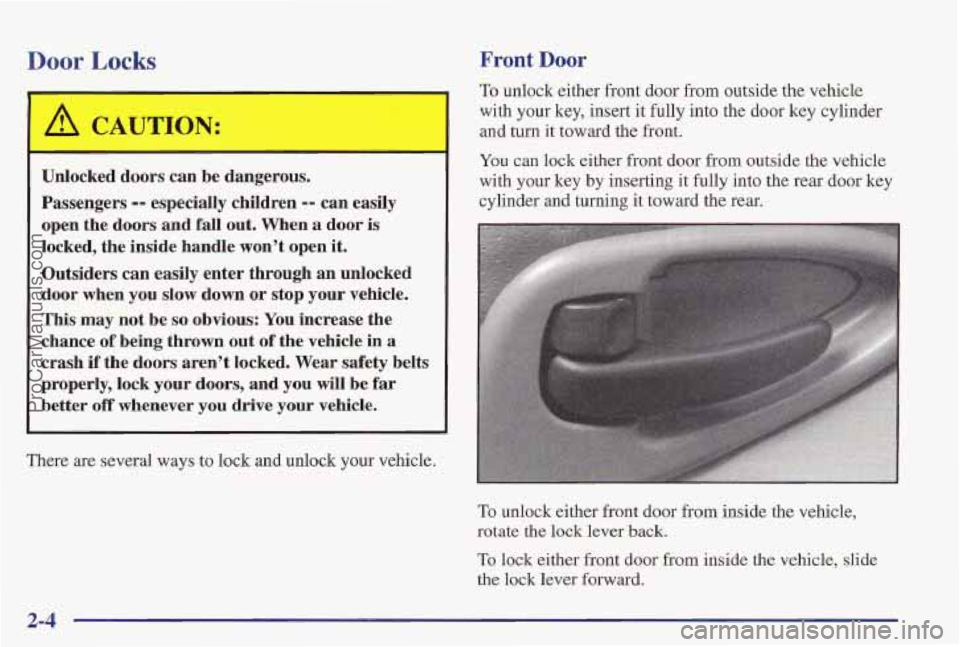
Door Locks Front Door
Unlocked doors can be dangerous.
Passengers
-- especially children -- can easily
open the doors and fall
out. When a door is
locked, the inside handle won’t open
it.
Outsiders can easily enter through an unlocked
door when you slow down or stop your vehicle.
This may not
be so obvious: You increase the
chance of being thrown
out of the vehicle in a
crash if the doors aren’t locked. Wear safety belt:
properly, lock your
doors, and you will be far
better off whenever you drive your vehicle.
To unlock either front door from outside the vehicle
with your key, insert it fully into the door key cylinder
and turn it toward the front.
You can lock either front door from outside the vehicle
with your key by inserting it fully into the rear door key
cylinder and turning it toward the rear.
There are several ways to lock and unlock your vehicle.
To unlock either front door from inside the vehicle,
rotate the lock
lever back.
To lock either front door from inside the vehicle, slide
the
lock lever forward.
2-4
ProCarManuals.com
Page 80 of 419
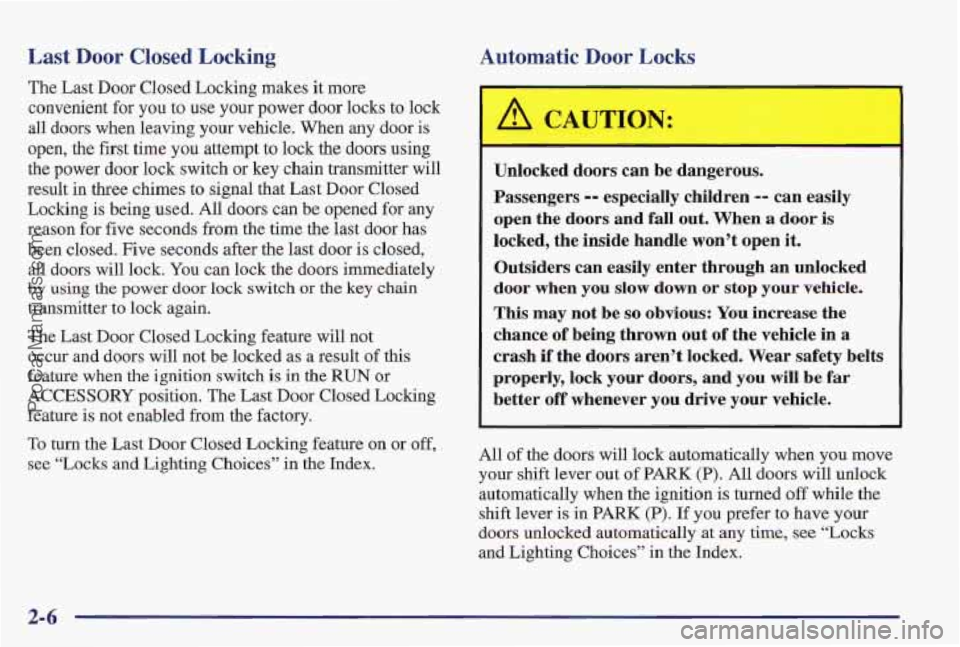
Last Door Closed Locking
The Last Door Closed Locking makes it more
convenient €or you to use your power door lo’cks to lock
all doors when leaving your vehicle. When any door
is
open, the first time you attempt to lock the doors using
the power
door lock switch or key chain transmitter will
result in three chimes to signal that Last
Door Closed
Locking is being used. All doors can be opened for any
reason for five seconds from the time the last door has
been closed. Five seconds after the last door is closed,
all doors will lock. You can lock the doors immediately
by using the power door lock switch or the key chain
transmitter
to lock again.
The Last Door Closed
Locking feature will not
occur and d’oors will not
be locked as a result of this
feature when
the ignition switch is in the RUN or
ACCESSORY position. The Last Door Closed Locking
feature
is not enabled from the factory.
Automatic Door Locks
I
Unlocked doors can be dangerous.
Passengers -- especially children -- can easily
open the doors and fall out. When
a door is
locked, the inside handle won’t open
it.
Outsiders can easily enter through an unlocked
door when you slow down or stop your vehicle.
This
may not be so obvious: You increase the
chance
of being thrown out of the vehicle in a
crash
if the doors aren’t locked. Wear safety belts
properly, lock your doors, and you will
be far
better off whenever you drive your vehicle.
To turn the Last Door Closed Locking feature on or off,
see “Locks and Lighting Choices” in the Index. All of the
doors will lock automatically when you move
your shift lever
out of PARK (P). All doors will. unl’ock
automatically when the ignition
is turned off while the
shift lever
is in PARK (P). If you prefer to have your
doors unlocked automatically at any time, see “Locks
and Lighting Choices” in the Index.
2-6
ProCarManuals.com
Page 86 of 419
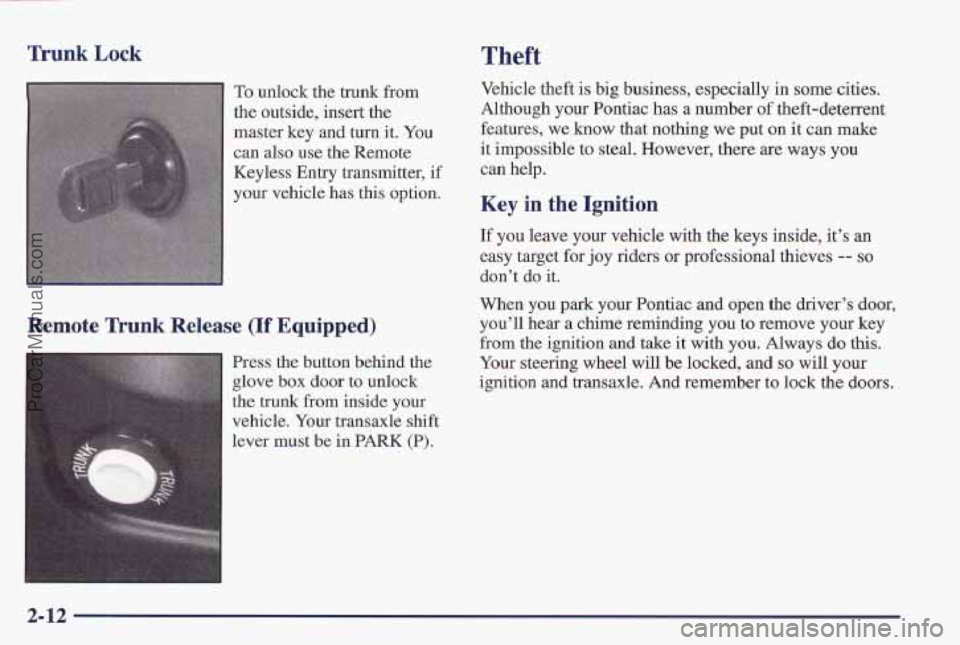
Trunk Lock Theft
To unlock the trunk from
the outside, insert the
master key and
turn it. You
can also use the Remote
Keyless Entry transmitter, if
your vehicle has this option.
Remote Trunk Release (If Equipped)
Press the button behind the
glove box
door to unlock
the trunk from inside your
vehicle. Your transaxle shift
lever
must be in PARK (P).
Vehicle theft is big business, especially in some cities.
Although your Pontiac has a number of theft-deterrent
features, we know that nothing we put on
it can make
it impossible to steal. However, there are ways you
can help.
Key in the Ignition
If you leave your vehicle with the keys inside, it’s an
easy target for
joy riders or professional thieves -- so
don’t do it.
When you park your Pontiac and open the driver’s door,
you’ll hear a chime reminding you
to remove your key
from the ignition
and take it with you. Always do this.
Your steering wheel will be locked, and so will your
ignition and transaxle. And remember to lock the
doors.
2-12
ProCarManuals.com
Page 113 of 419

go : Turn the knob to this symbol to turn on the headlamps
and other operating lamps.
PG: Turn the knob to this symbol to turn on the parking
and other operating lamps without the headlamps.
Turn the knob to
OFF to turn off the lamps.
Daytime Running Lamps
Daytime Running Lamps (DRL) can make it easier for
others to see the front of your vehicle during the day.
DRL can be helpful in many different driving
conditions,
but they can be especially helpful in the
short periods after dawn and before sunset.
A light sensor on top of the instrument panel makes the
DRL work, so be sure it isn't covered.
The DRL system will make your low-beam headlamps
come on at a reduced brightness when:
0 The ignition is on,
0 The headlamp switch is off, and
0 The parking brake is released.
When the
DRL are on, only your low-beam headlamps
will be on. The taillamps, sidemarker and other lamps
won't be on. Your instrument panel won't be lit up either.
When it's dark enough outside, your headlamps will change to full brightness. The other lamps that come on
with your headlamps will also come on.
When it's bright enough outside, the regular lamps will
go out, and your low-beam headlamps change to the
reduced brightness of DRL.
To idle your vehicle with the DRL off, set the parking
brake while the ignition is in
OFF or LOCK. Then start
your vehicle. The DRL will stay
off until you release the
parking brake.
As with any vehicle, you should turn on the regular
headlamp system when you need it.
ProCarManuals.com
Page 120 of 419
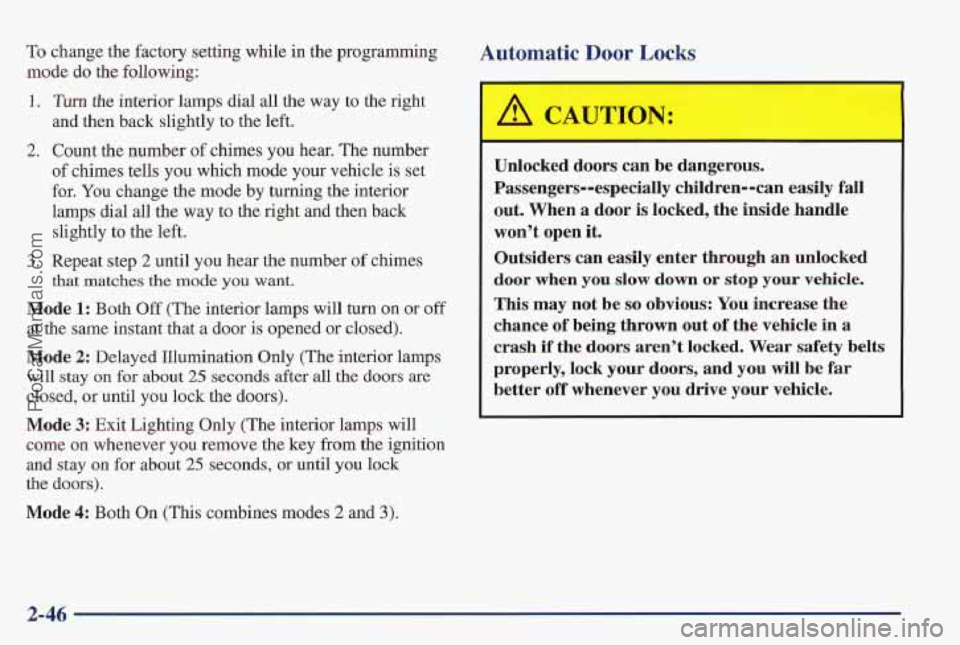
To change the factory setting while in the programming
mode do the following:
1. Tun the interior lamps dial all the way to the right
and then back slightly
to the left.
2. Count the number of chimes you hear. The number
of chimes tells you which mode your vlehide is set
for. You change the mode by turning the interior
lamps dial all
the way to the right and then back
slightly
to the left.
3. Repeat step 2 until you hear the number of chimes
Mode 1: Both Off (The interior lamps will turn on OF off
at the same instant that a door is opened or closed).
Mode 2: Delayed Illumination Only (The interior lamps
will
stay on for about 25 seconds after all the doors are
closed, or until you lock the doors).
that matches the mode you want.
Mode 3: Exit Lighting Only (The interim lamps will
come on whenever you remwe
the key from the ignition
and stay on for about 25 seconds, or until you lock
the doors).
Mode 4: Both On (This combines modes 2 and 3).
Automatic Door Locks
A CAUTION:
Unlocked doors can be dangerous.
Passengers-especially children-can easily fall
out. When
a door is locked, the inside handle
won’t open it.
Outsiders can easily enter through an unlocked
door when you slow down or stop your vehicle.
This may
not be so obvious: You increase the
chance
of being thrown out of the vehicle in a
crash
if the doors aren’t locked, Wear safety belts
properly, lock your doors, and you will be far
better off whenever you drive your vehicle.
2-46
ProCarManuals.com
Page 190 of 419
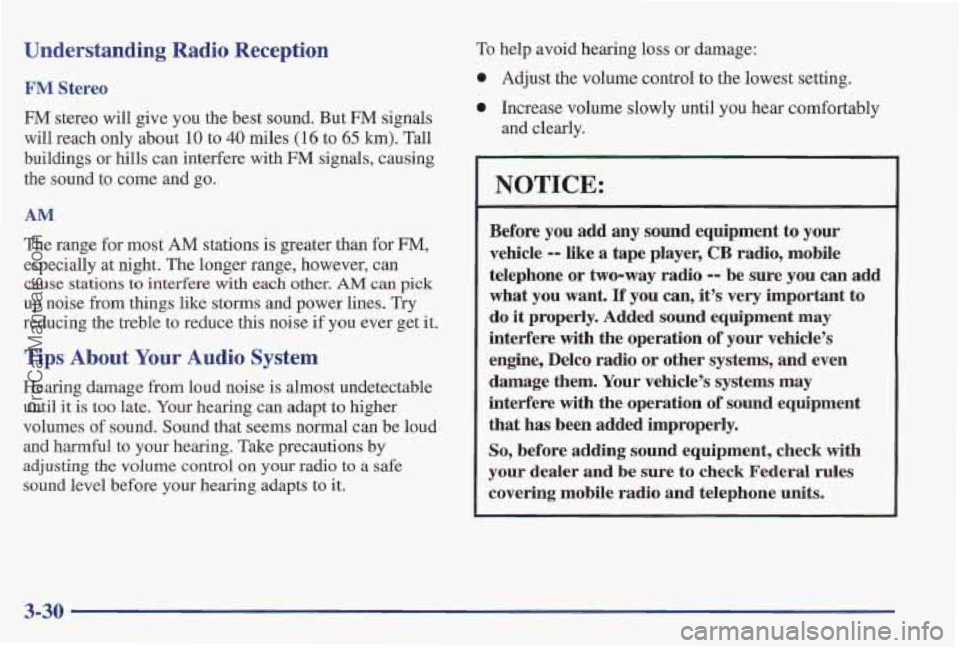
Understanding Radio Reception
FM Stereo
FM stereo will give you the best sound. But FM signals
will reach only about 10 to
40 miles I( 16 to 65 km). Tall
buildings or hills can interfere with
FM signals, causing
the sound to come and go.
AM
The range for most AM stations is greater than for FM,
especially at night. The longer range, however, can
cause stations to interfere with each other.
AM can pick
up noise from things like storms and power lines. Try
reducing
the treble to reduce this noise if you ever get it.
Tips About Your Audio System
Hearing damage from loud noise is almost undetecrade
until
it is too late. Your hearing can adapt to higher
volumes
of sound. Sound that seems normal can be loud
and harmful to
your hearing. Take precautions by
adjusting
the volume control on your radio to a safe
sound level before your hearing adapts to it.
To help avoid hearing loss or damage:
0 Adjust the volume control to the lowest setting.
0 Increase volume slowly until you hear comfortably
and clearly.
NOTICE:
Before you add any sound equipment to your
vehicle
-- like a tape player, CB radio, mobile
telephone or two-way radio
-- be sure you can add
what you want.
If you can, it’s very important to
do
it properly. Added sound equipment may
interfere with the operation of your vehicle’s
engine, Delco radio
or other systems, and even
damage them. Your vehicle’s systems may
interfere with the operation of sound equipment
that
has been added improperly.
So, before adding sound equipment, check with
your dealer and be sure
to check Federal rules
covering mobile radio and telephone units.
3-30
ProCarManuals.com
Page 199 of 419
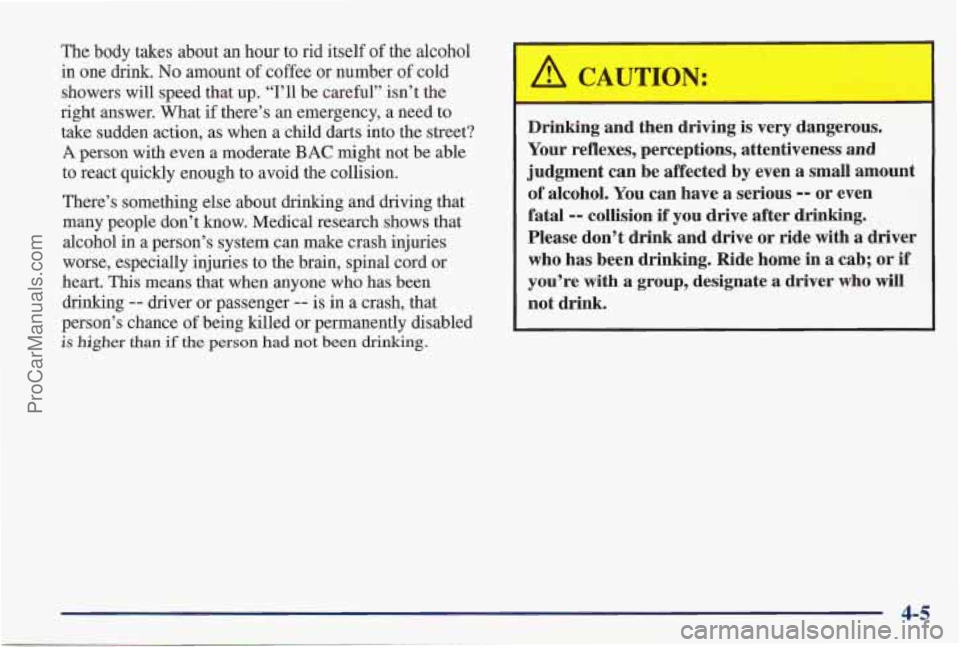
The body takes about an hour to rid itself of the alcohol
in one drink.
No amount of coffee or number of cold
showers will speed that up. “I’ll be careful” isn’t the
right answer. What
if there’s an emergency, a need to
take sudden action, as when a child darts into the street?
A person with even a moderate BAC might not be able
to react quickly enough to avoid the collision.
There’s something else about drinking and driving that
many people don’t
know. Medical research shows that
alcohol in a person’s system can make crash injuries
worse, especially injuries to’ the brain, spinal cord or
heart. This means that when anyone who has been
drinking
-- driver or passenger -- is in a crash, that
person’s chance of being killed or permanently disabled
is higher than if the person had not been drinking.
. Drinking and then driving is very dangerous.
Your reflexes, perceptions, attentiveness and
judgment can be affected by even a small amount
of alcohol. You can have a serious -- or even
fatal
-- collision if you drive after drinking.
Please don’t drink and drive or ride with
a driver
who has been drinking. Ride home in a cab;
or if
you’re with a group, designate a driver who will
not drink.
4-5
ProCarManuals.com